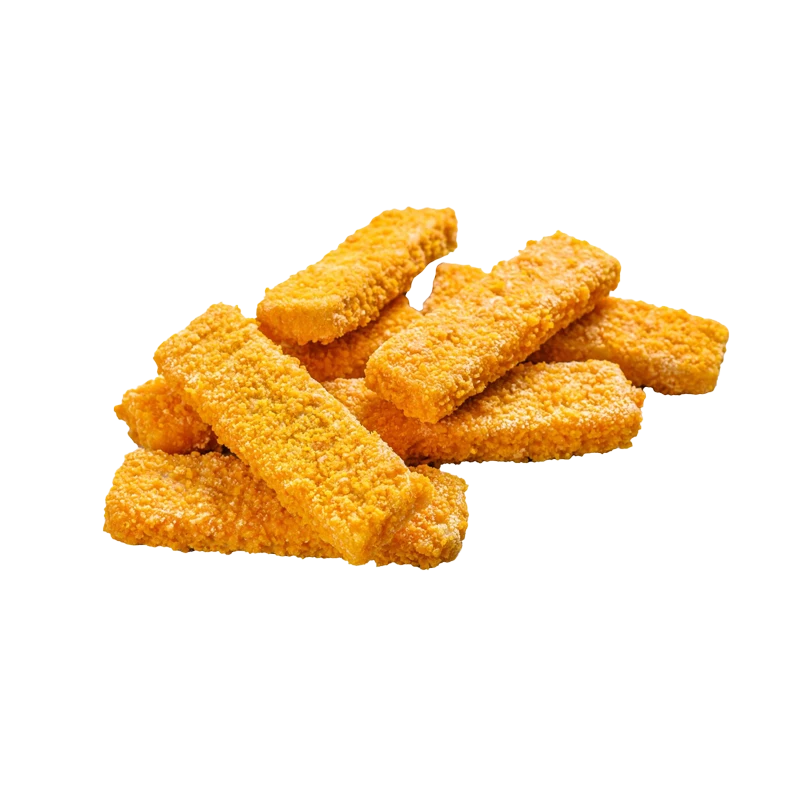Fish Sticks — Nutrients, Health Benefits, And Shopping Tips

Written by Listonic Team
Last update on September 4, 2024
Fish sticks nutrients
Nutrition facts
Amount per 100 g
Calories
🔥 229 kcal
| Nutrition per: 100 g | Value | % Daily Value* |
|---|---|---|
| Carbs | 24 g | 8.73% |
| Fiber | 1 g | 3.57% |
| Sugars | 1 g | 2% |
| Glycemic Index | 63 | - |
| Protein | 11 g | 22% |
| Sodium | 350 mg | 15.22% |
| Total Fat | 10 g | 12.82% |
*The % of Daily Value (DV) tells you how much a nutrient in a serving of food contributes to a daily diet. 2,000 calories a day is used for general nutrition advice.
11 g
🧀 Good Protein Content
1 g
🍏 Low Sugar Content
Fish sticks facts & tips
Health benefits
- High in protein, essential for muscle growth, repair, and overall body function.
- Contains essential vitamins and minerals such as Vitamin B12, iodine, and selenium, which support overall health and well-being.
- May provide omega-3 fatty acids if made from fatty fish like cod or pollock, which support heart and brain health.
- Convenient and easy to prepare, making them a quick and nutritious meal option.
Health risks
- High fat content particularly in fried fish sticks, which can raise cholesterol levels and increase the risk of heart disease when consumed frequently.
- High sodium content in many commercial fish sticks, which can contribute to hypertension and increased cardiovascular risks.
- Low nutrient density as fish sticks often contain a small amount of fish relative to the breading and fillers, offering limited vitamins or minerals compared to whole fish.
- Potential for added preservatives and artificial ingredients in some commercial fish sticks, which may cause adverse reactions in sensitive individuals.
- Risk of contamination with harmful bacteria if fish sticks are not properly cooked or stored, leading to potential foodborne illness.
How to choose fish sticks
Perfect for a quick meal, fish sticks should be uniformly coated with breadcrumbs that adhere well, ensuring they crisp up nicely when cooked. The fish inside should be white and flake easily, indicating it is of good quality.
Avoid fish sticks that appear soggy or have a grayish color to the fish, as they may be old or improperly processed. Packages that are damaged or have freezer burn should also be avoided, as they can affect the taste and texture of the fish sticks.

How to store fish sticks
Fish sticks should be kept in the freezer until ready to use. Freezing maintains their texture and flavor for up to six months. Store them in their original packaging or a freezer-safe container.
Air exposure can cause freezer burn, affecting the quality of fish sticks. Avoid leaving them uncovered, and always reseal the packaging tightly. Ensure they are cooked thoroughly from frozen to maintain safety and taste.
✅ Extra Tip
How long do they last?
Fish sticks can last for 1-2 days in the refrigerator once cooked. For longer storage, fish sticks can be frozen for up to 6 months. Ensure they are stored in an airtight container to maintain their quality and flavor, making them convenient for quick meals.
What to do with leftovers?
Leftover fish sticks can be used in a variety of savory and kid-friendly dishes. Chop them up and add to salads, wraps, or sandwiches for a quick and easy protein, or mix them into a pasta dish with your favorite sauce. Fish sticks are also great when used as a filling for tacos or burritos with fresh salsa and avocado.
Use fish sticks in a fish stick casserole by layering them with vegetables, cheese, and breadcrumbs, then baking until golden. If you have a lot of fish sticks, consider making a batch of fish stick sliders with tartar sauce and pickles. Fish sticks can also be sliced and added to a pizza or flatbread, or used as a topping for a fish and chips bowl with fries and coleslaw. For a quick snack, enjoy fish sticks with a side of dipping sauce like tartar, ketchup, or honey mustard.
👨⚕️️ Medical disclaimer
Discover products from other categories
Listonic Team
Fact-checked
Our editorial team checked this article to make sure it was accurate at the time of publishing it.
Get the top-rated shopping list app

fish sticks
1 piece
Outline







